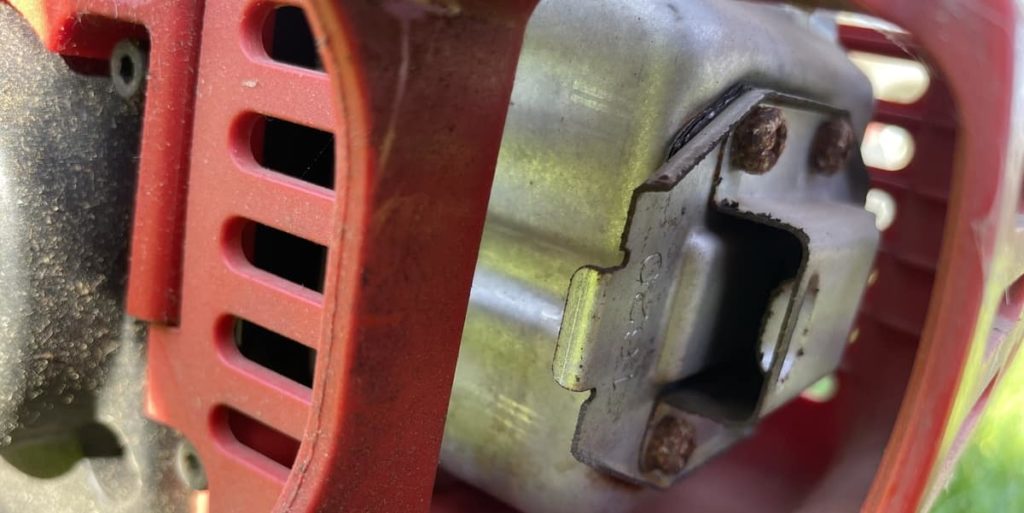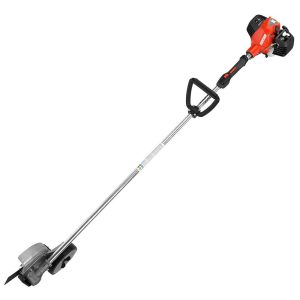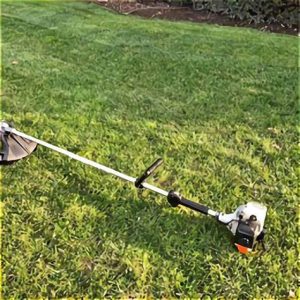Reasons Your Shindaiwa String Trimmers Starts, Stalls and Dies
It’s that time of the week to mow the lawn. This includes trimming around the landscaping, trees, water features, and fence posts to give your lawn a well-manicured appearance. However, this week you run into a problem with your string trimmer where you can start it, but it just won’t keep running.
A Shindaiwa string trimmer will start and then die when it isn’t getting continual air, fuel or spark required to stay running. This can be the result of a plugged air filter, bad fuel, plugged fuel filter, clogged fuel line, bad fuel tank vent, dirty carburetor or bad spark plug.
A plugged spark arrestor can also cause a Shindaiwa to shut down.
Before working on your Shindaiwa, make sure you unplug the spark plug wire, wait for all moving parts to stop and wait for the engine to cool.

This post may include affiliate links. Purchases made through these links may provide a commission for us, at no extra cost to you. As an Amazon Associate, we earn from qualifying purchases.
Follow all safety instructions provided in your equipment operator’s manual prior to diagnosing, repairing, or operating.Consult a professional if you don’t have the skills, or knowledge or are not in the condition to perform the repair safely.
Table of Contents
8 Reasons Your Shindaiwa String Trimmer Starts Then Dies
Incorrect Choke Setting Causes a Shindaiwa String Trimmer to Start Then Die
There is a lever on your Shindaiwa that controls the choke. The choke is placed in the closed position to start the trimmer when the engine is cold. This restricts airflow allowing a higher concentration of fuel to be burned in the cylinder.
Once the engine has warmed, the choke lever must be adjusted to the open position. When this isn’t done, the engine will sputter and shut down because it isn’t getting sufficient air to continue to run.
Plugged Air Filter Causes a Shindaiwa String Trimmer to Start Then Die
Another item that can cause an airflow restriction resulting in your trimmer dying is the air filter. A clean air filter allows air to pass through the filter while keeping out dirt and debris.
When the air filter isn’t regularly cleaned or replaced, it can build up so much dirt that a good amount of air can’t pass through the filter. This can cause your Shindaiwa string trimmer to stall and die.
When you find your air filter isn’t in good condition, replace it. Never run the trimmer without an air filter even if it’s just to finish up a job. Doing so can introduce dirt to the engine and cause wear and damage.
I recommend replacing the air filter once a year. If you use your filter more often than the average homeowner or in very dirty conditions, you should replace your air filter more often.
Inspect and clean your air filter regularly. When you find it is very dirty, wet or damaged, it’s time to replace it with a new filter. Follow the instructions below to clean and replace your air filter.
Clean a Shindaiwa string trimmer felt air filter:
- Remove the air filter cover and remove the air filter.
- Wipe any dirt or debris remaining in the air filter cover or housing.
- Brush the dirt off the air filter.
- Install the clean filter.
- Reattach the air filter cover.
Clean a Shindaiwa foam pre-cleaner filter (if your model uses one):
The pre-cleaner can be cleaned with water and a mild dish detergent solution. Rinse until the water runs clear and squeeze it to remove all water. Allow it to dry before installing. DO NOT ADD OIL to the pre-filter.
Because there are so many different types of filters used which varies from model to model, refer to your operator’s manual for steps to clean different types of air filters for your string trimmer.
Old or Bad Fuel Causes a Shindaiwa String Trimmer to Start Then Die
Running the wrong type of gas or old gas can cause your Shindaiwa trimmer to run sluggish and possibly die. Most types of gasoline contain ethanol. This is an alternative fuel that is often made from corn. This fuel is not good for the small engine on your string trimmer.
Ethanol attracts moisture from the air. This water and ethanol mixture can negatively affect the trimmer by corroding components and gumming up the fuel system. Because of this, it’s important to use gas with a low ethanol content.
Shindaiwa string trimmers require gasoline and oil mixed at a ratio of 50:1. Mix unleaded gasoline of a minimum octane rating of 89 and a maximum ethanol content of 10% with a premium 2-cycle oil that is ISO-L-EGD and JASO M345 FD certified.
Using the wrong type of oil or the wrong amount of oil can result in engine damage. Never run straight gas through your Shindaiwa string trimmer. This is a sure way to ruin the trimmer and have to purchase a new one.
Gas can begin breaking down as soon as 30 days after purchase. Add a fuel stabilizer like Sea Foam Motor Treatment to fresh fuel to make it last a little longer without breaking down. A fuel stabilizer can help minimize fuel issues from running old gas.
Keep in mind some 2-cycle oils include a fuel stabilizer. Even though the bottle of oil states it includes a stabilizer, read the fine print to see how long the additive will keep the fuel stable. You will find it will keep it stable anywhere between 30 days and 2 years.
Read more about choosing the right gas and how to care for it in “This is the Type of Gas and Oil Shindaiwa String Trimmers Use“.
Plugged Fuel Filter Causes a Shindaiwa String Trimmer to Start Then Die
To keep dirt and debris from entering the fuel system, you will find a small filter located inside the fuel tank. It is attached to the end of the fuel line. The filter can become plugged when it isn’t replaced regularly.
The fuel restriction caused by the plugged filter can keep your Shindaiwa from running. I recommend changing the fuel filter annually.
If you use your string trimmer more than the average homeowner or find your fuel is very dirty, you will have to replace it sooner. When using it for commercial purposes, I recommend replacing the fuel filter every 3 months.
Replace a Shindaiwa fuel filter:
- Wipe around the fuel cap to remove dirt and debris so they don’t fall into the tank.
- Remove the cap.
- Pull the fuel filter out of the fuel tank. A clean bent wire works well to retrieve the filter.
- Once the filter is out of the tank, remove it from the fuel line. Be careful not not lose the retaining ring. Keep the ring on the fuel line.
- Attach the new fuel filter by inserting the male end into the fuel line and securing the line to the filter using the retaining ring.
- Place the fuel filter back inside the fuel tank.
- Install the fuel cap.
Clogged Fuel Lines Cause a Shindaiwa String Trimmer to Start Then Die
Old fuel can leave behind gummy deposits that can restrict fuel flow through the fuel lines. When this happens, remove the fuel line and install a new fuel line of the same diameter and width. You will need to replace the fuel line if you find it is dry, cracked, or kinked.
Plugged Fuel Tank Vent Causes a Shindaiwa String Trimmer to Start Then Die
The Shindaiwa fuel tank requires a vent to allow air to pass through it. When this vent gets plugged, the fuel tank forms a vacuum. The vacuum prevents fuel from flowing out of the tank which causes the trimmer to stall and die.
If you are not getting fuel to the carburetor, you are running a good filter and you don’t have any clogs in the fuel lines, you may have a clogged fuel vent. You can test this by placing your Shindaiwa string trimmer on a level surface.
Loosen the fuel cap to allow air into the tank and start the trimmer. Don’t allow gas to spill out of the fuel tank. When the trimmer starts and runs, replace the fuel cap with the trimmer still running.
Continue to let it run for a while. If it sputters and dies with the cap on and then starts and runs once the cap is removed, you most likely have a problem with the fuel tank vent.
Replace the vent with a new fuel tank vent. This is a small part that is found coming off a line out of the fuel tank.
Dirty Carburetor Causes a Shindaiwa String Trimmer to Start Then Die
The carburetor mixes the correct proportion of air and fuel required for your Shindaiwa string trimmer to run. The passageways can become clogged and the small components can fail to function correctly.
This can cause an insufficient amount of fuel mixed with air resulting in a rough running string trimmer that may just quit. You may be able to clean your carburetor to get it working again. You may end up having to rebuild it (if rebuild kits are available for your carburetor) or replace the carburetor if cleaning doesn’t help.
Before replacing a carburetor, I recommend comparing the cost of the carburetor and labor expense to the cost of a new Shindaiwa string trimmmer. Depending on the model, cost, and age of your string trimmer, you may be better off purchasing a new one.
Plugged Spark Arrestor Causes a Shindaiwa String Trimmer to Start Then Die
There is a small metal screen that keeps hot exhaust material from shooting out of the string trimmer and causing injury or starting a fire. This small screen will become plugged with a carbon buildup that will affect how the engine runs.
Disconnect the spark plug wire. On most Shindaiwa models, you will remove the engine cover and the engine exhaust cover to access the spark arrestor screen. Carefully remove the spark arrestor screen and clean it with a metal brush.
If the screen isn’t able to be sufficiently cleaned or you find it is damaged or has a hole in it, replace it with a new spark arrestor screen.
Contact your local Shindaiwa dealer if you are having trouble locating the spark arrestor screen or if you are continuing to experience problems with your Shindaiwa string trimmer.







